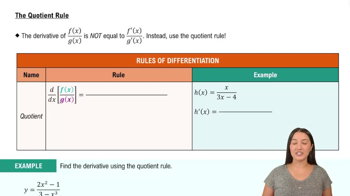Here are the essential concepts you must grasp in order to answer the question correctly.
Logarithmic Differentiation
Logarithmic differentiation is a technique used to differentiate complex functions by taking the natural logarithm of both sides. This method simplifies the differentiation process, especially for products, quotients, or powers, by transforming multiplicative relationships into additive ones. It is particularly useful when dealing with functions that involve variable exponents or products of functions.
Recommended video:
Logarithmic Differentiation
Product and Quotient Rules
The product rule and quotient rule are fundamental differentiation rules in calculus. The product rule states that the derivative of a product of two functions is the first function times the derivative of the second plus the second function times the derivative of the first. The quotient rule, on the other hand, provides a method for differentiating a quotient of two functions, ensuring that the derivative accounts for both the numerator and denominator.
Recommended video:
Chain Rule
The chain rule is a crucial differentiation technique used when differentiating composite functions. It states that the derivative of a composite function is the derivative of the outer function evaluated at the inner function, multiplied by the derivative of the inner function. This rule is essential for handling functions where one function is nested within another, allowing for accurate differentiation of complex expressions.
Recommended video:
 Verified step by step guidance
Verified step by step guidance Verified video answer for a similar problem:
Verified video answer for a similar problem:



 6:30m
6:30m